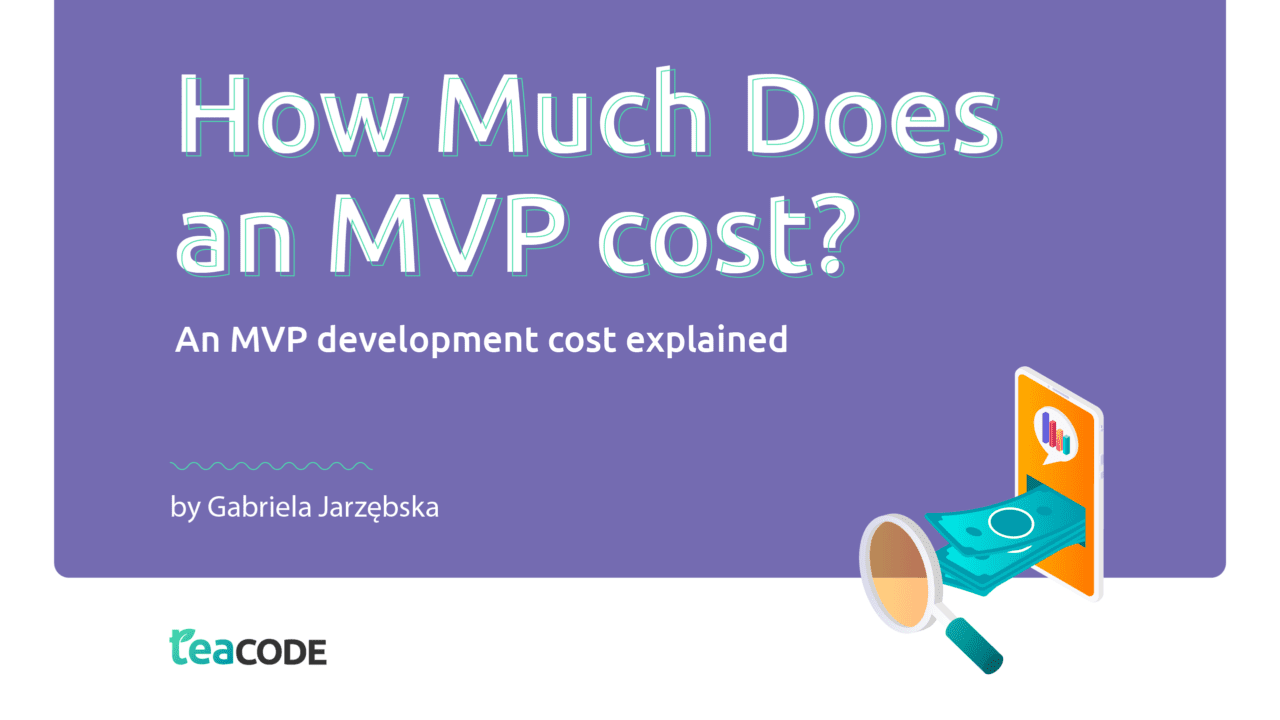
Table of content
- MVP types and prices
- What impacts the MVP development cost?
- Mobile app vs web app development cost
- Examples of how to define an MVP app cost
- Uber-like MVP development
- Social media MVP development
- Fitness MVP development
- E-learning platform MVP development
- Booking app MVP development
- Food Ordering MVP development
- Parcel Delivery App development
- Dating Tinder-like MVP development
- Music streaming app like Spotify MVP development
- Cryptocurrency MVP development
- Grocery MVP development
- Trip Planning MVP development
- Smart home MVP development
- So, how to assess the initial MVP development budget needed?
Do you want to build a Minimum Viable Product and wonder how much it costs to prepare or assess your initial budget? No problem, the answer is really simple – an MVP costs exactly as much as you want to spend.
Surprised? Let me explain.
An MVP can mean many things, and its cost depends on what you want to create, what your business needs are, and what your budget is. The cost can vary from a few hundred to a few hundred thousand dollars.
I know it might sound strange, but please bear with me; it will make much more sense in a moment. If you’re unsure what an MVP is (or what it can be), check out my article, where I explain the meaning of the MVP in detail.
You may also be wondering why in many cases, MVP cost estimates are that widely apart. Well, that might be a side effect of a lack of understanding of the project, so if you want to receive the most accurate estimates possible, prepare a good requirements specification (you can check how to do that in my article on gathering requirements).
Need a hand with estimating your MVP app?
MVP types and prices
Let’s have a look at a couple of scenarios and determine what will be a Minimum Viable Product for each of them. It depends on the MVP concept which you choose for your project.
Situation A:
Case: I have super limited funds, and the goal of my MVP is to check if anyone will be interested in my product.
What would you do in this scenario? I’d record a short demo video showing my product’s planned core features. I would promote it all over my social media and send it directly to the companies that might be interested. After a few days, I would analyze the interest in the video, its views, likes, and comments.
This way, with only my time and video editor’s fee invested, I would get information if the product sounds interesting to anyone. This is enough information to decide on going into a larger investment.
Of course, reactions to a video aren’t a perfect market measuring tool, but it’s cheap, quick, and can be a great starting point for an entrepreneur with limited resources.
Minimum Viable Product solution: Demo video
MVP development costs: < $1 000
Pros: quick, cheap, provides quick feedback
Cons: not professional, moderately reliable data
Great for: first idea verification in case of very limited funds. Better for targeting individuals than companies
Situation B:
Case: I have a few thousand to invest and want to analyze market demand for my product.
My recommendation, in this case, is to build a landing page that describes the product, looks professional, and, most importantly, has the “Sign for a newsletter” functionality. I would use no-code solutions like WordPress or Wix to minimize the costs. I would prioritize page marketing over its complexity and custom design.
As a result, I have a simple but informative landing page, basic marketing tools, and, most importantly, I start building a customer base from the newsletter subscriptions. Don’t forget to connect analytic tools like Google Analytics to track how many people visit the page. It will give you crucial insights into how many people are interested in the product.
Minimum Viable Product solution: Landing Page
MVP development costs: $1 000 – $5 000
Pros: quick, cheap, gather contact to potential customers, reliable data
Cons: none, this is a perfect MVP 😉
Great for: Demand analysis, creating customer database, building product and brand awareness
Situation C
Case: I want to test my product on real users.
Now, we finally get to what’s commonly understood as an MVP (and the MVP app development). To test the product on end users, gather feedback about the functionalities and maybe even start selling, I need to build a simple version of my application. The first version.
I would definitely recommend choosing only the most important MVP features to implement. The more complex the app is, the more it costs, but this is not the only reason. The main purpose of an MVP is to check if users like our product and its functions. If we overwhelm them with additional features, it will be impossible to gather reliable feedback about crucial parts of the application.
A factor that has a humongous impact on the price is desired scale. Depending on how much I know about the demand for my product and my budget, I would decide whether I want to build a simple prototype that is suitable for a few hundred users or a scalable application for hundreds of thousands of customers.
Minimum Viable Product solution: Application with basic features and simple UI for up to 1000 users
MVP development costs: $5 000 – $50 000 (depending on complexity)
Pros: reasonable price, build user database, reliable data, and feedback
Cons: time – development will take a few weeks to a few months, not scalable – harder to gather a large user group
Great for: Gathering feedback for functionalities and UX design. It can also be used to find external funding.
Minimum Viable Product solution: Scalable application with basic features
MVP development costs: $50 000 – $500 000 (depending on complexity, and designs)
Pros: end product – scalable and sellable, reliable data and feedback
Cons: time – development will take at least a few months, large investment, huge risk if the idea was not properly validated
Great for: Investors with a lot of resources and certainty about their idea
What impacts the MVP development cost?
A few factors influence the final cost of an application the most. There’s no difference whether we’re talking about the web, desktop, or mobile app development. Those always matter.
There are multiple factors affecting the MVP cost, but the most important and significant are:
- type of development team
- hourly rate of your development company
- type of contract
- technology stack & the scale of the app
- the scope of the project: design & functionalities
Type of development team
First of all, the key is who will be developing your app. You have 3 options: hire an in-house development team, choose freelance developers or outsource MVP development to a software development company.
Each of them has its pros and cons. If you want to learn more, check Mike Popov’s articles on outsourcing and building your in-house team comparison and analysis of who is better to hire: freelance developers or a software development company.
Let’s summarise. Hiring a software development company is usually the cheapest way to your MVP development as you are provided with every talent you might need (including a project manager to manage the product development process). Those people are used to working with each other, and they take the burden of project management off your shoulders. Based on their experience, they can also suggest better and cheaper solutions.
Hourly rate as an MVP costs factor
Hourly rates might be considered the most important factor in defining the MVP app cost. Let’s say you have a perfectly estimated man-hours demand; it’s up to the hourly rate how much that will cost.
Hourly rates depend on how many years companies are on the market, how many successful products they made, the level of expertise and seniority of developers (junior, mid, senior), and whether their competencies are unique.
The most important factor, however, is location. You need to assess whether hiring a local team or choosing onshore or offshore outsourcing is worthwhile.
Eastern Europe is the most attractive outsourcing region, known for its high development skills and low prices. In fact, Eastern Europe is the third region with the lowest prices, after Asia and Africa.
So, how much does it cost to hire a developer? Average hourly rates are different in various locations:
Region Average hourly rate
- North America: $100-$180
- South America: $30-$50
- Western Europe: $110-$200
- Eastern Europe: $25-$50
- Africa: $20-$40
- Australia: $100-$180
- Asia: $15-$40
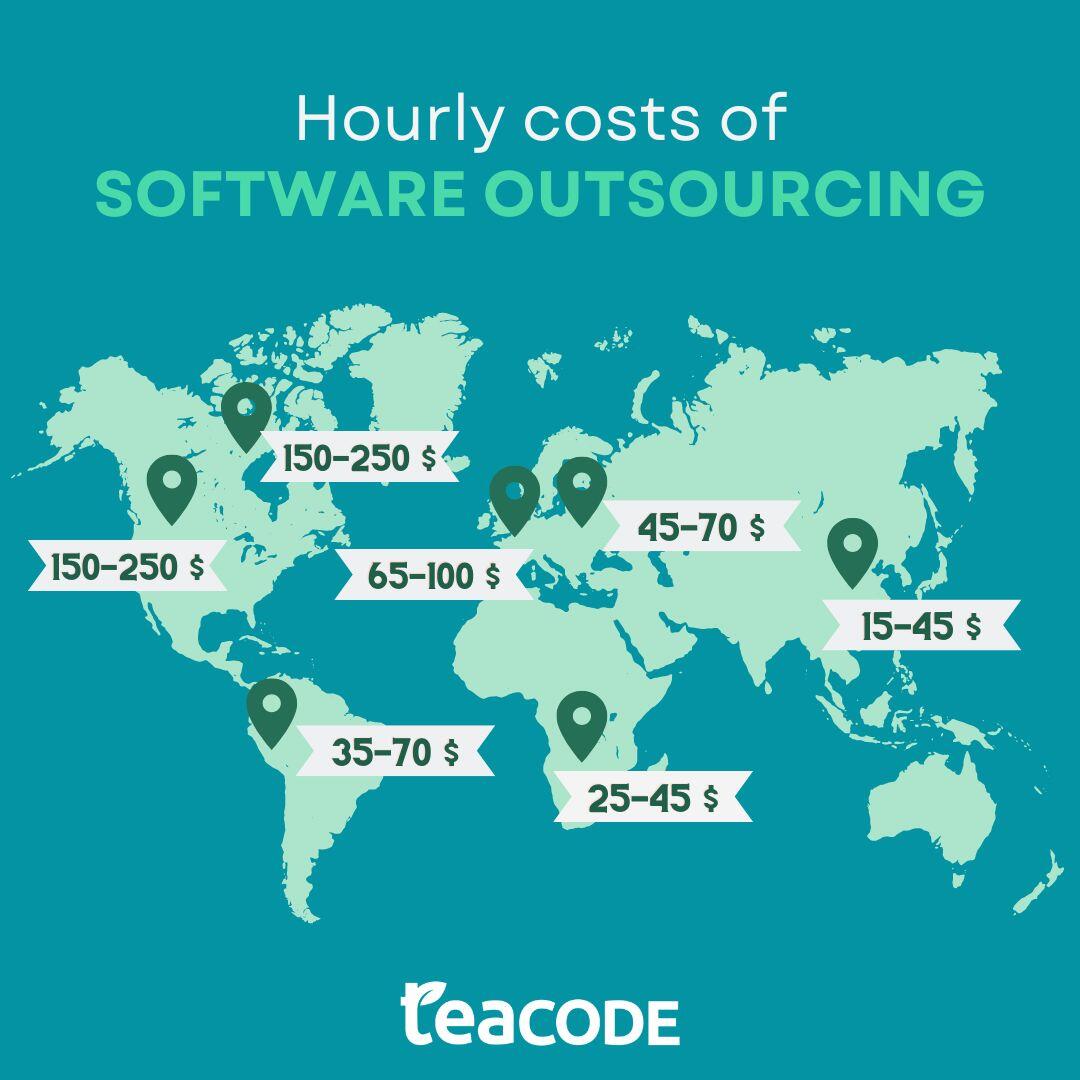
For more details on how hourly rates vary worldwide, check Gabriela Adynowska’s article on software outsourcing destinations.
Type of contract
Basically, you can choose a Fixed-Price, Time & Materials, and Milestone-based or a dedicated team contract. Mike Popov provided a comparison of those, extremely helpful when choosing the best model for your project development.
Keep in mind that this choice affects the entire development process and the MVP cost. Based on my experience, I recommend you Time & Materials contract as it gives you flexibility and is the most cost-effective at the end of the day. Fixed-Price contracts seem secure, but you usually pay more than you would in the case of T&M, to mention just one of the risks. If you want to find out the 6 risks and challenges associated with Fixed-Price contracts, check my article on that point.
Technology stack and scale of application
There are technologies easy to use for developers but not scalable or poorly optimized and technologies that offer more possibilities or better optimization but require an experienced development team to build something with them. When choosing a technology for your MVP, there is always a trade-off.
It is easier and faster to develop web applications than desktop or mobile apps, but a website opened on mobile will never look as good as a native application. It will probably also have more UX limitations.
Choosing what frontend you want to build is the first decision to make in the MVP app development, and the second is how to build it. There are tools like WordPress, which give you frontend applications fast and relatively cheap. However, it works slowly, is not that customizable, and scales poorly. On the other hand, maybe there is no point in building an incredible yet complex frontend before the idea is properly tested.
Backend technology can also strongly impact the implementation time and budget, but easy-to-implement solutions often have higher usage costs or are not designed for larger project scales.
I have 3 tips for choosing technology for the project development:
- Analyze your needs – There is no best tech stack, but there can be the best tech stack for your project. Application for million users will require a different tech stack than internal company tools for a few employees. When you create an app for Gen-Z Americans, there is no point in building it for Android, as 80% of the market uses iOS. Analyze your goals and needs, and make decisions only based on that.
- Trust the experts – the choice is enormous, and without knowing the options, it’s not possible to make the right choice, that’s why ask experts for advice and let them guide you through the decision.
- Value seniority – most developers can learn new technologies, but it will take them much time and eat much of your budget. Hire teams with experience in the chosen tech stack, as they will do it faster and better, and even if their average hourly rate seems higher, you’ll pay less in the end.
Scope – design & app features
What defines an app’s complexity level are its functionalities. There might be very standard yet difficult-to-implement features like email status tracking, which is very challenging on the authorization level. Or non-standard solutions that require a lot of research, for example, integration with a custom 3rd party tool.
Keep in mind that an MVP idea is to build limited features and check whether there’s a demand for it.
I know you’re here for the specifics, so let’s break down a few most common app functionalities. I want to explain to you why it’s so hard to estimate them, and there is just no one price I can give you.
User authentication – Login, Signup, Password Recovery
There are several ways to approach this topic from a technical point of view. Each solution will have different development, maintenance, and usage cost. But overall, the time to implement the backend and frontend of Signup, Sign-in, Password Recovery Flow, and Logout functionality is about 4-6 development days (32-48 hours).
If you need social login, add 2-3 days (16-24 hours) for each provider (i.e. Google, Apple, Facebook, Github).
If you want to have a non-standard authentication, like passwordless login, it requires at least 5-6 additional days. Same for the Two Factor Authentication.
Features
- Signup, Sign-in, Password Recovery Flow, and Logout: 32-48 hours
- Social login: 16-24 hours per provider
- Non-standard authentication: 40-48 hours
- Two Factor Authentication: 40-48 hours
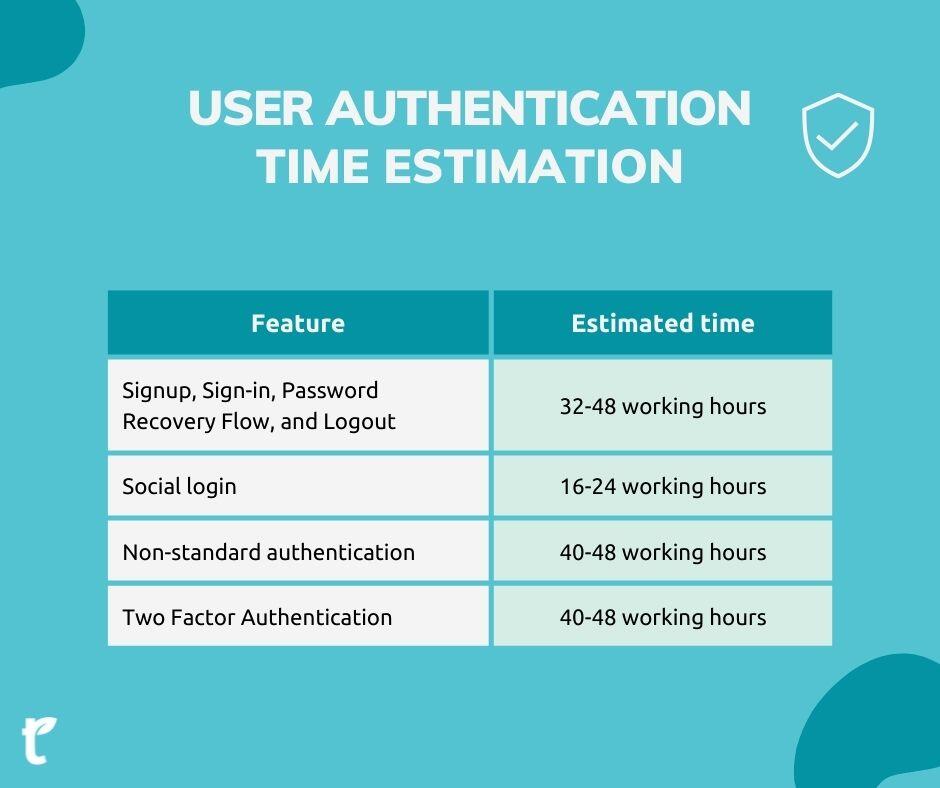
Chat
Chat is one of the most popular features and is used in all applications with social interactions. The cost of implementing a chat can vary between 5 man days to 5 months. What influences the difference? Building an elementary chat with standard UI components will probably take an experienced developer around a week. Still, the chat has a huge potential to have awesome functions, and building them might take months.
Maybe you’ve noticed that at the beginning, as an MVP app, the Instagram chat was extra basic, even primitive. You couldn’t share images, there were no likes to messages, no group chat, you couldn’t resend messages after failure, and there was no information if the reader saw your message. All these features were added step by step over the years. Advanced chat tools like Slack offer much more than that and believe me, it took them years to implement and optimize.
Chat
- Basic 1-on-1 messages: 40 hours
- Messanger-like chat: 800 hours (no calls or camera filters)
- Slack-like chat: over 1 year (>2000 man hours)
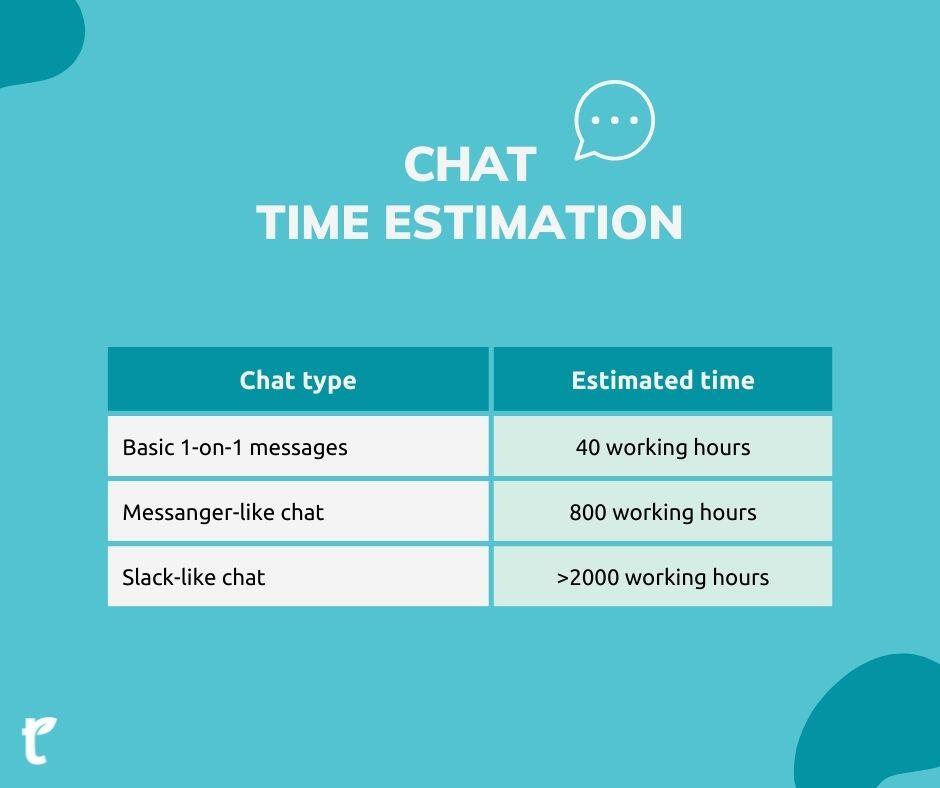
Online/In-app shopping
It is a very useful tool to monetize your application, and implementing a simple ‘Buy now’ button can be straightforward and take 2 development days. Of course, if you use the right tools (like Stripe), it is a simple flow. The development time increases if your application needs shopping cart functionality, requires invoicing, automated emails, or any other shopping-related features. Unless shopping is not your core functionality, I wouldn’t expect implementation will take longer than a month, even with quite advanced features.
Features:
- Simple buy now button: 16 hours
- shopping cart functionality: 40 hours
- Basic shopping cart functionality: 160 hours
- In-app Invoicing panel: 40-60 hours
- Automated emails: 40-60 hours
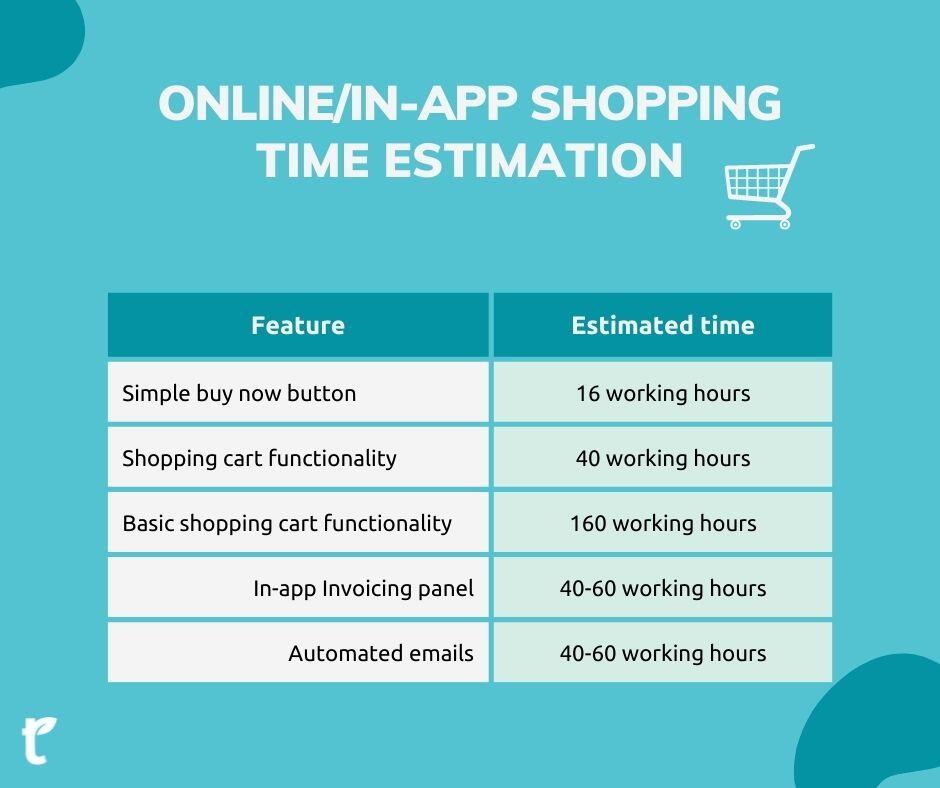
Features that influence the whole estimate
I could discuss a million cases like this, but let’s stop here and mention only one additional topic regarding functionalities pricing. There are some features that impact the whole application, and their cost is a percentage value of the overall estimate. These functions influence all features of the app on the front-end and usually add significant backend complexity.
The time-consuming factor of such features is calculated based on all other app requirements. To estimate the time needed to build such features, we add a percentage value to the previously prepared estimation. It’s done that way because the bigger your app is, the more work it requires to build those solutions.
Examples of that can be:
- User types and permissions: 30-70% depending on the differences between the roles.
- Localisation: 20-30%.
- Use of Headless CMS: 20-30%
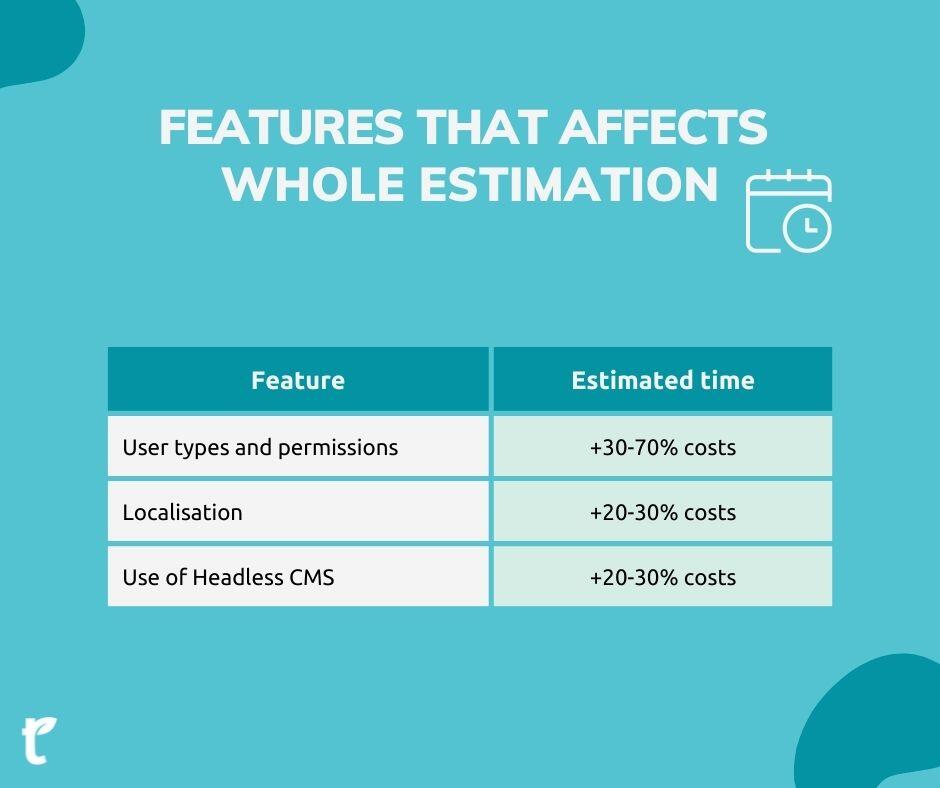
Another thing to explain is why the percentage for user types and permissions is so inaccurate. The final value depends on how complicated the solution is. If different kinds of users vary only according to what app elements they can see, it takes far less time than when we must develop practically two apps – one for each kind of user. The best example might be an e-commerce platform or an auction app when the company’s and buyers’ interfaces and functionalities are totally different.
I hope this gives you an overview of how much different apps might cost, but most of all, you understand that it is extremely hard to estimate projects without knowing the requirements.
UI design
Another factor aside from the coding process that can hugely impact the application’s cost is its design. Right now on the market, there are tons of UI templates available, using them speeds development up, but you don’t get a fully custom, one-of-a-kind application, so there’s another trade-off.
Very unique UI designs may increase the whole application cost even twice, especially for mobile development, but I’m sure for some businesses, it is worth the money because it will generate value. More about how to design an app you’ll find in this ultimate guide.
In the case of an MVP development, I would rather recommend using templates and adjusting them to your brand as possible.
The devil in the details
The Pareto principle says that roughly 80% of consequences come from 20% of causes. This applies to software development, too (including MVP development). The most essential features that make up most of the app’s value cost only 20% of the budget while developing tiny details and improvements can consume up to 80% of the budget.
Let’s take a look at an example. You can see a super simple app navigation panel in the image below? It is obviously not pretty, but it has functionality.
We used a ready element from a component library to add this functionality to the app. Implementation of it took around an hour, but there are plenty of things we should improve for it to match production standards:
- improve colour contrast – instead of using theme blue, we should use custom colour for the texts -> 20 minutes
- there should be a few pixels margin between the icons and texts -> 20 minutes
- user should be able to close the menu by any outside click, and right now, they can only click the arrow next to the user icon to do it -> 30 minutes
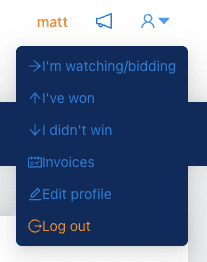
These are just very basic enhancements, and we have already doubled the implementation time. It would probably take a few hours if the design was more custom and we couldn’t use predefined components. And we’re only discussing the UI of a navigation panel, imagine what happens when we have complex user flows with many pages and backend involved.
As you can see, the details matter. They greatly impact the MVP development cost but can strongly affect the user experience. The question is, what is the goal of your application, and what budget do you have for disposal?
The component presented above was used in a bidding portal that main goal was to gather clients and start making money. Now that the business is functioning, there is an additional budget for investing in the page, redesigning it, and improving the UX. Page was very simple and cheap, allowing the owner to invest mostly the business’s money, not private funds.
Mobile app vs web app development cost
Before you start MVP development, you need to define what kind of app you want to build. That will affect the MVP price. Web development is usually a bit easier than mobile. Therefore, web applications will be 10-20 % cheaper.
If you decide to build a mobile app, there are other options to consider. The two most popular operating systems are Android and iOS. Each has a different user base, so it’s very important to check what will be the main system for your end users. An application for cryptocurrency trading will probably have much more Android over iOS users, but if you’re building another TikTok for the US market, it’s probably better to prioritize iOS.
Of course, every time you decide to go for only one OS, you lose part of the potential market. That’s why there are hybrid applications that allow developers to code functionalities once and handle both systems. Hybrid app development takes a bit more time than focusing on one platform, but if you know from the start that you want to go for both, there is no point in developing the application separately, it will take much longer and cost much more.
Examples of how to define an MVP app cost
As we already know, an MVP development cost varies significantly depending on the features of the app. So, how much does it cost to develop the MVP in the case of a particular app?
Take a look at the list I prepared below. These most popular applications are broken down into the most important features and roughly estimated as an MVP. I assumed they don’t need to be scalable, the UI is simple, and the functionalities are basic. I would say it’s a list of minimum prices for specific MVPs.
The apps described below present scopes that we think are price-to-value optimally balanced. An app with fewer features might be considered below expectations, and additional features are extensions that increase the price with no significant value.
Uber-like MVP development
Let’s take a look at how much it costs to build an MVP for an app like Uber. In this case, we have two parties – a driver and a client. That app needs to have a map with driver location and ordering functionality. The driver receives a notification that someone booked the course and should be able to accept or reject it. The app should also process online payments.
The second part of such a project would be an admin panel for drivers’ management.
Crucial MVP features and the average overall cost:
- user authentication (sign-in, signup, recover password): 160 h
- location tracking and maps: 120 h
- 2 user types – client and driver: 200 h
- real-time queries and responses (to address rides booking): 40 h
- admin panel: 120 h
- notifications: 80 h
- online payments: 40 h
Overall estimation: 760 h -> $40k
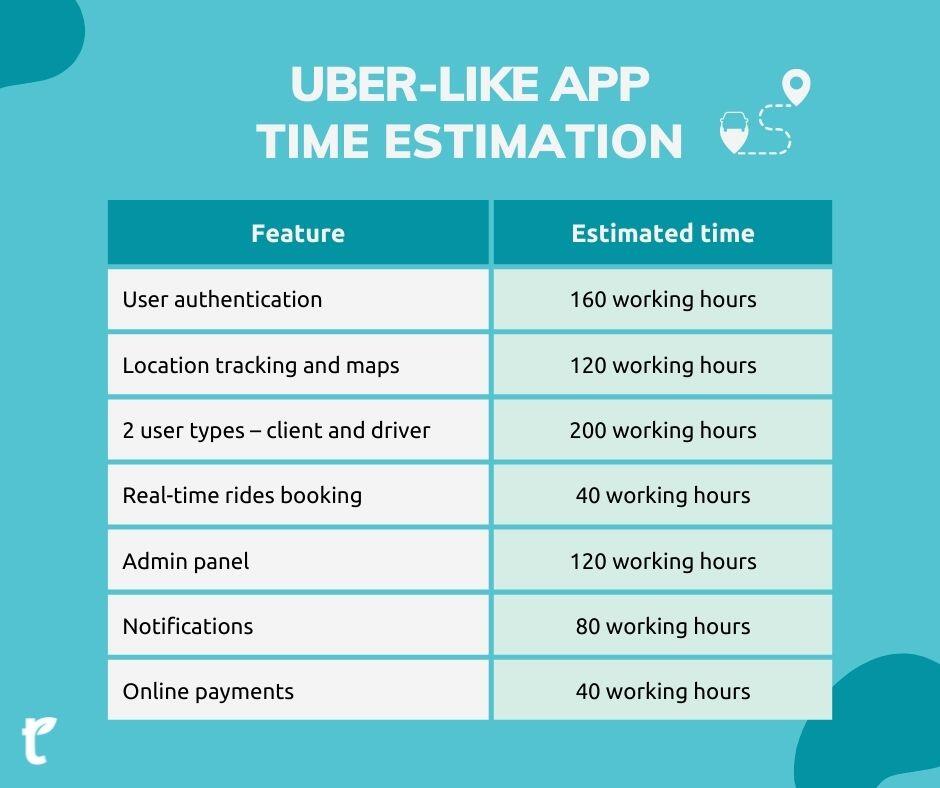
Fitness MVP development
To build an MVP of a fitness app, you need two elements: an admin panel for content, users, and subscription management and an app for users with core features. Users can buy a subscription, watch movies, mark them as favourites, and track progress. The app should send push notifications to motivate users to do some exercises.
The average MVP development price contains:
Admin Panel:
- manage content: 80 h
- manage users: 30 h
- manage subscriptions: 40 h
App:
- user authentication (sign-in, signup, recover password): 160 h
- browse and view content: 120 h
- search content: 60 h
- purchase and manage subscription: 120 h
- track watched and favourites: 60 h
- track progress: 20 h
- push notifications (reminders): 60 h
Overall estimation: 750h -> $40k
E-learning platform MVP development
If you’re about to build an MVP for an e-learning platform, you need to provide solutions for creators of courses and for learners. For creators, you need to provide a content management solution. Learners, on the other hand, need to search, buy and view courses and be able to mark some as favourites (the finished ones should be automatically marked as watched or completed).
In this case, the average minimum viable product estimation contains:
- user authentication (sign-in, signup, recover password): 160 h
- 2 user types – creator and learner: 80 h
- manage content: 120 h
- browse, search and view content: 200 h
- purchase courses or subscriptions: 80 h
- track watched and favourites: 60 h
- email reminders: 80 h
Overall estimation: 780h -> $40k
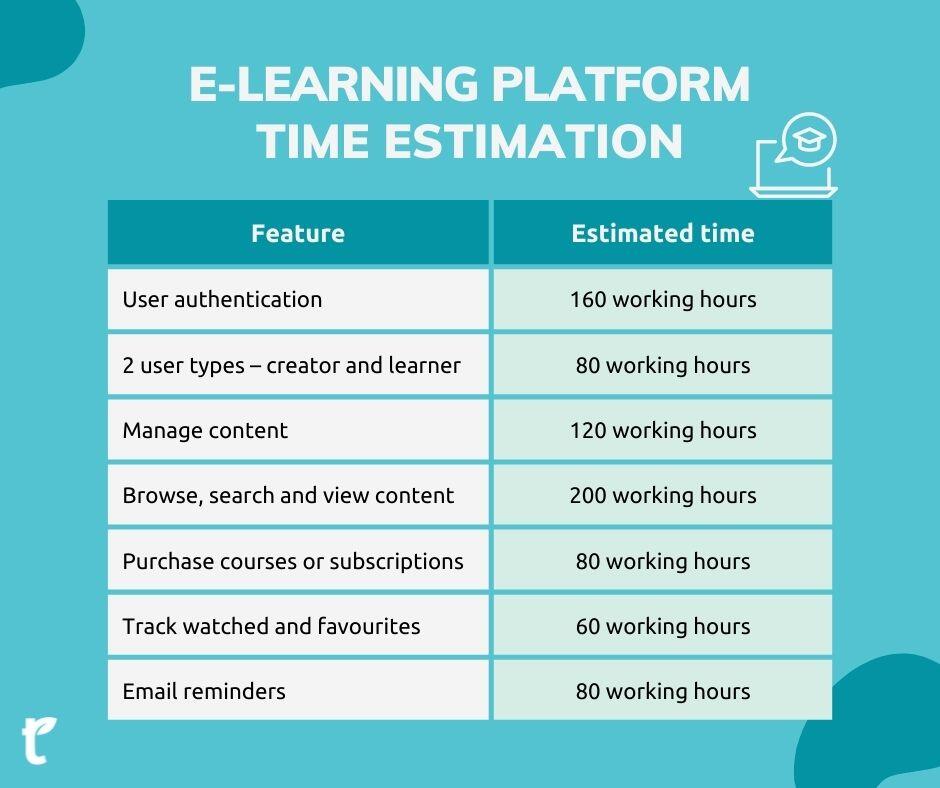
Booking app MVP development
Let’s take a look at the cost of MVP development for a basic accommodation booking solution. There are companies and clients. Clients should be able to search for hotels, book them (they should not see currently booked places, so we need real-time data processing) and pay for them online. Companies need an admin panel to manage their offers.
The average MVP development cost:
- user authentication (sign-in, signup, recover password): 160 h
- 2 user types – companies and clients: 200 h
- browse, search and filter accommodations: 160 h
- book hotels: online purchase, real-time data processing: 160 h
- email reminders: 80 h
- admin panel for hosts: 160 h
Overall estimation: 920h -> $45k
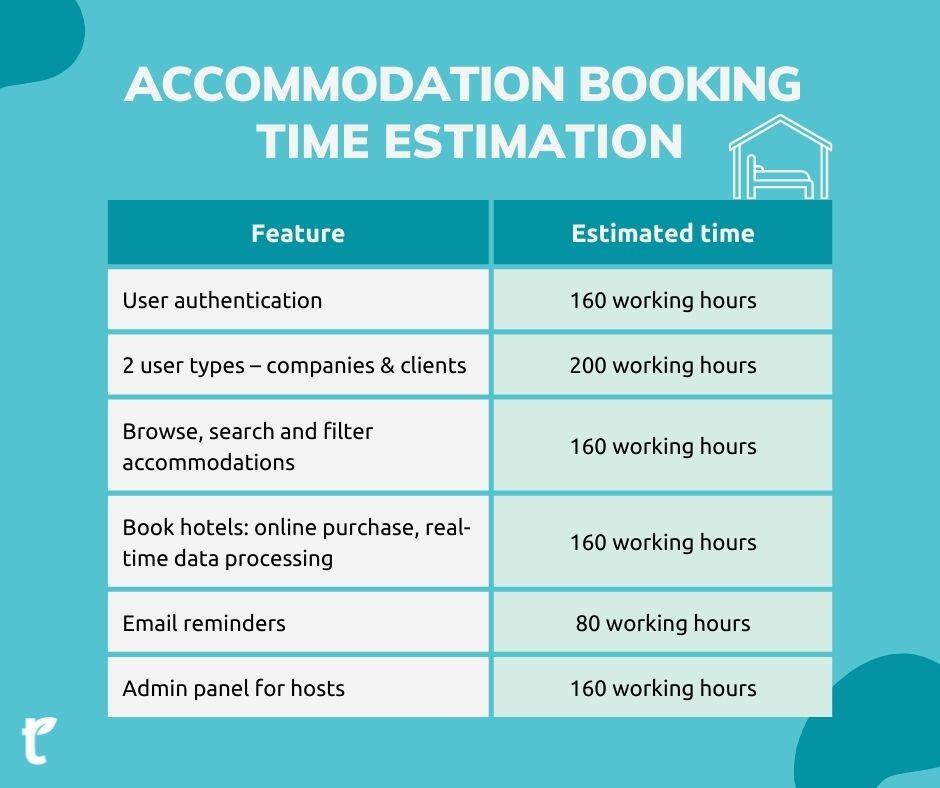
Food Ordering MVP development
Let’s investigate the cost of building an MVP app for food delivery from restaurants. Such an app should provide interfaces for clients and vendors (restaurant admins). Vendors should be able to customise their offers using an admin panel. Users can search for and order a meal and pay for it online (optionally, personal takeout with paying on the place might decrease costs). They should be notified about order status changes and check where the delivery person is (optionally, if delivery and online payment are provided). After purchase, they should be able to rate the restaurant.
The app should also contain a master admin for restaurants and user management.
The overall average development cost summary:
- 2 user types – client and vendor: 100 h
- restaurant admin: 100 h
- create an order: real-time data processing: 100 h
- notifications: 80 h
- browse, filter, and search: 80 h
- order status tracking: 40 h
- restaurants rating: 40h
- master admin: 80h
- online payments: 40 h (optionally)
- location tracking: 80 h (optionally)
Overall estimation: 620-740 h -> $35-$40k
Parcel Delivery App development
Let’s assess the MVP price for a delivery app based on a user-only app with no admin panel. The app should be integrated with the company system to get and display information about parcels. Users should be logged in to see their parcels’ details and add external packages to be watched (with basic info only). Additionally, the app might allow users to send parcels.
The average cost to build a parcel delivery app:
- delivery status tracking: 120h
- user authentication (sign-in, signup, recover password): 160 h
- list, search packages: 24h
- add and watch packages: 40h
- send functionality: 120h (optional)
Overall estimation: 344-464h -> $20-$25k
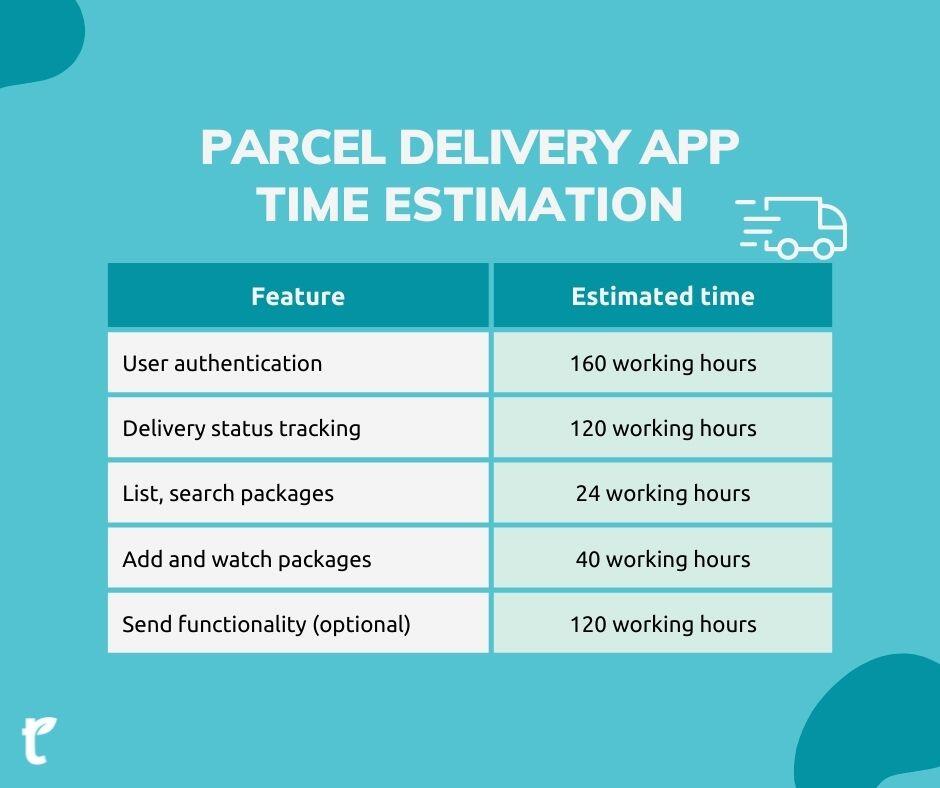
Dating Tinder-like MVP development
In a mobile app like Tinder, users must be able to log in, build their profiles (photo, description, predefined attributes; no posts) and vote for other profiles by swiping. Profiles they see must be recommended based on users’ preferences and previous choices (you can develop a very simple and not smart algorithm or use an AI/ML-driven tool like TeaRex.AI to provide better recommendations and decrease costs).
Users should be able to chat but in a very simple way – only text messages or images are allowed (with no reactions, responses to particular messages and similar advanced functions).
Optionally, you can implement a simple monetisation model.
The average Tinder-like MVP mobile app cost:
- user authentication (sign-in, signup, recover password): 160 h
- user profile: 80 h
- suggestion algorithm: 40-160 h
- swiping – likes/dislikes: 80 h
- chat: 80 h
- monetization: 160 h (optional)
Overall estimation: 440-720h -> $25-$40k
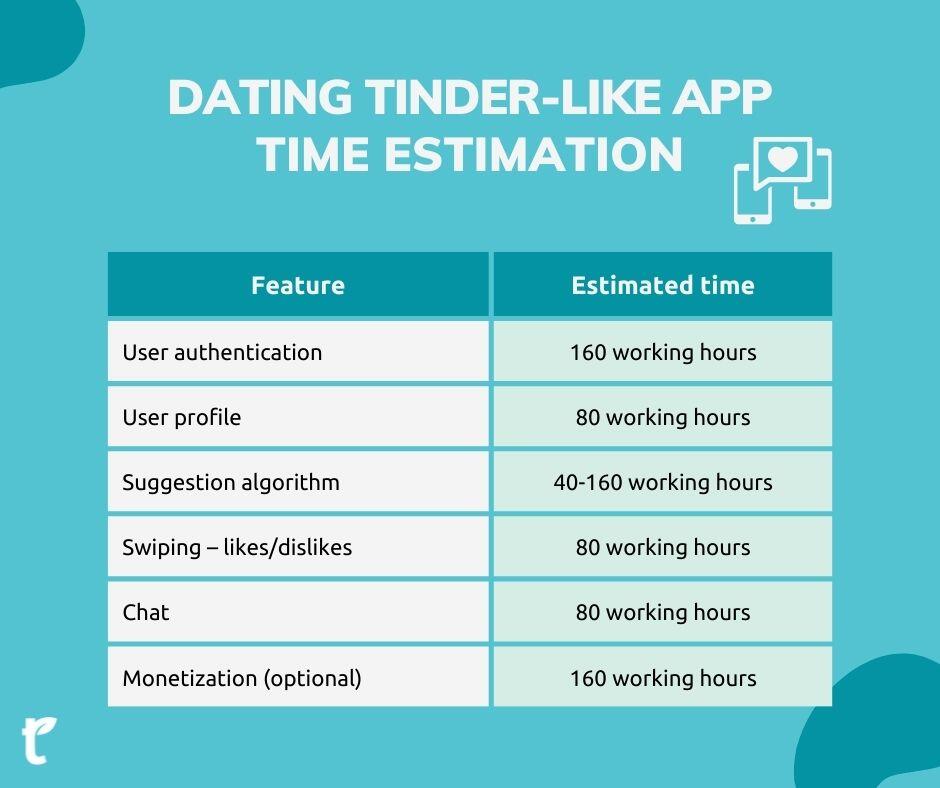
Music streaming app like Spotify MVP development
The cost of building a streaming app will be investigated based on a Spotify-like app. People can log in, search for music, like or dislike some items, add them to favourites, check the history of songs they listened to and buy subscriptions. Users should receive recommendations tailored to them (you can use an engine like TeaRex.AI to provide more precise recommendations at a significantly lower cost).
Such features as autoplay and playing when the mobile screen is locked are crucial for user experience but are demanding in the development simultaneously (and time-consuming).
Aside from the user interface, the app must provide an admin panel for content management. I assume that music files are added manually to the server at this stage. It’s a good case for further development to synchronise your application with external databases.
An average development cost to build a Spotify-like contains:
- user authentication (sign-in, signup, recover password): 160 h
- content management panel: 320 h
- subscriptions – online payments: 120 h
- browse, search and filter content: 80 h
- suggestion algorithm: 40-160 h
- user library – likes, dislikes, favourites, history: 240 h
- autoplay: 80 h
- locked screen functions: 80 h
Overall estimation: 1120-1240h -> $55-$65k
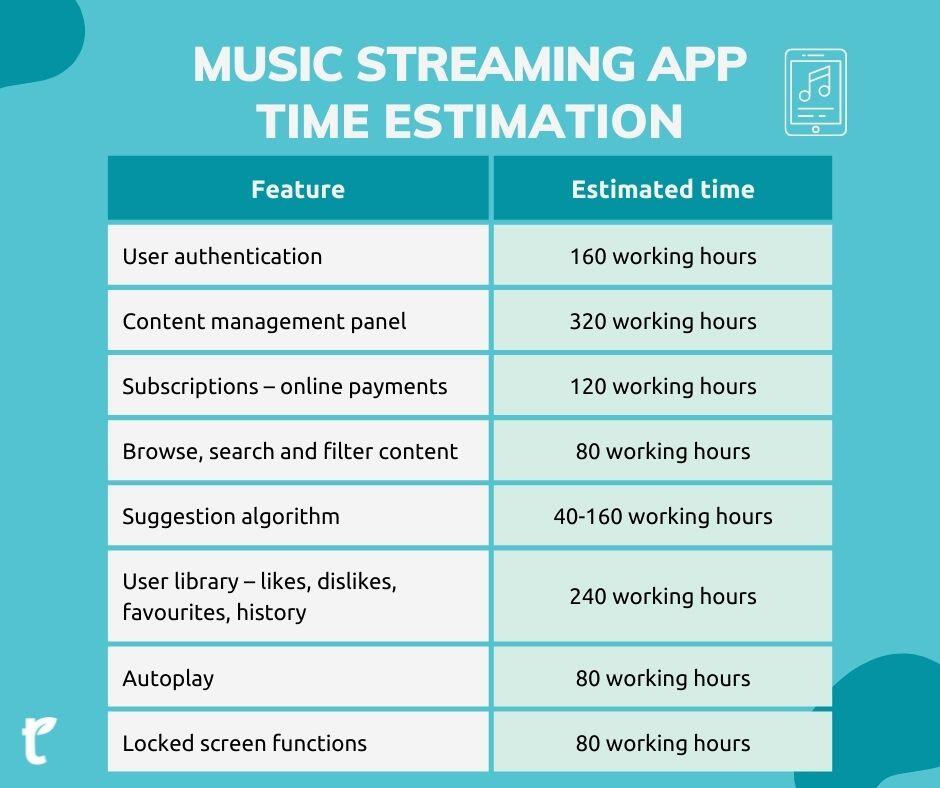
Cryptocurrency MVP development
First of all, the cryptocurrency app must be perfectly secured, and in many cases, clients insist on developing every single feature by us (which increases the price as well as security). We need a login feature with secure two-factor authentication. Let’s say that in the app, people can buy, place sell orders, exchange cryptocurrencies and check their wallets. They should be able to see numbers as graphs and charts.
The app must be integrated with a stock market app to provide real-time insights. It must be lightning-fast, and the connection must be stable, reliable and secure. There’s no place for issues.
The average cost to build an MVP for cryptocurrency should contain costs of:
- user authentication (sign-in, signup, recover password): 200 h
- virtual wallet: 120 h
- 3rd party integration – crypto stock API: 240 h
- real-time data and queries: 120 h
- data representation – graphs, notifications: 260 h
- transactions – sell, buy: 120 h
Overall estimation: 1060h -> $55k
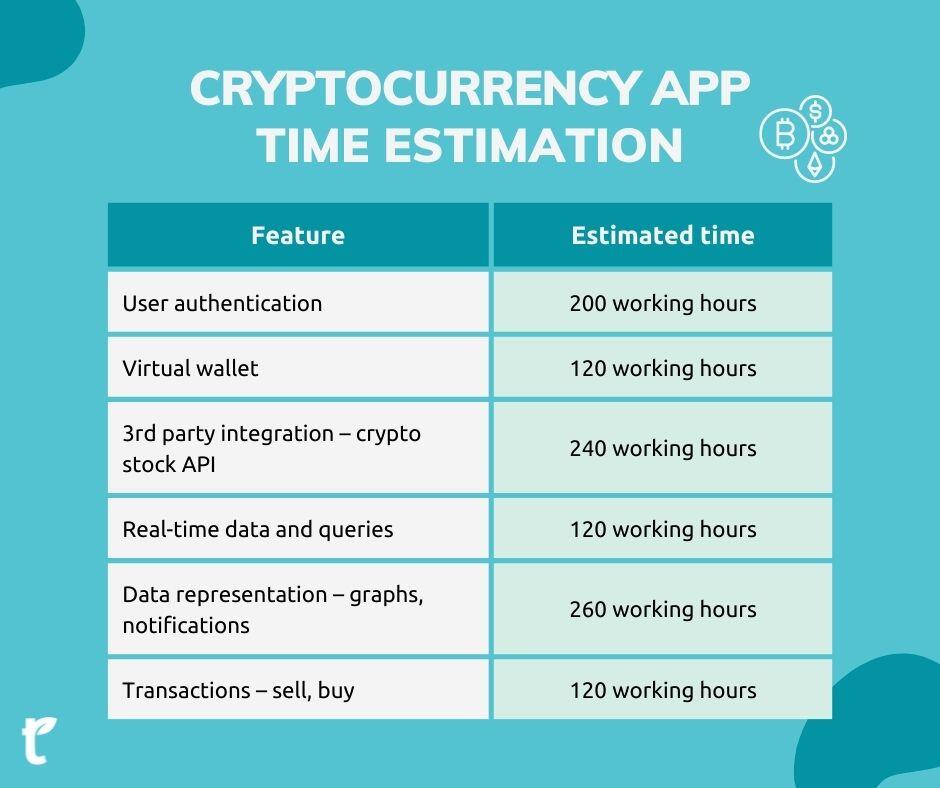
Grocery MVP development
To build an MVP for online market shopping, we should create a user area and admin panel. Administrators need to manage the products (integration for stock management might be needed), users, orders and so on. Users need to be able to log in, browse products, place orders and pay for them online. They also should be able to track parcel status (so integration with a delivery solution is needed).
The average costs might look like this:
- user authentication (sign-in, signup, recover password): 160 h
- online payments: 60 h
- browse, filter, search for products: 120 h
- order tracking: 40 h
- 3rd party integrations:
- storage tracking: 80 h
- deliveries: 80 h
Admin panel:
- manage products: 80 h
- manage orders: 80 h
Overall estimation: 700h -> $35k
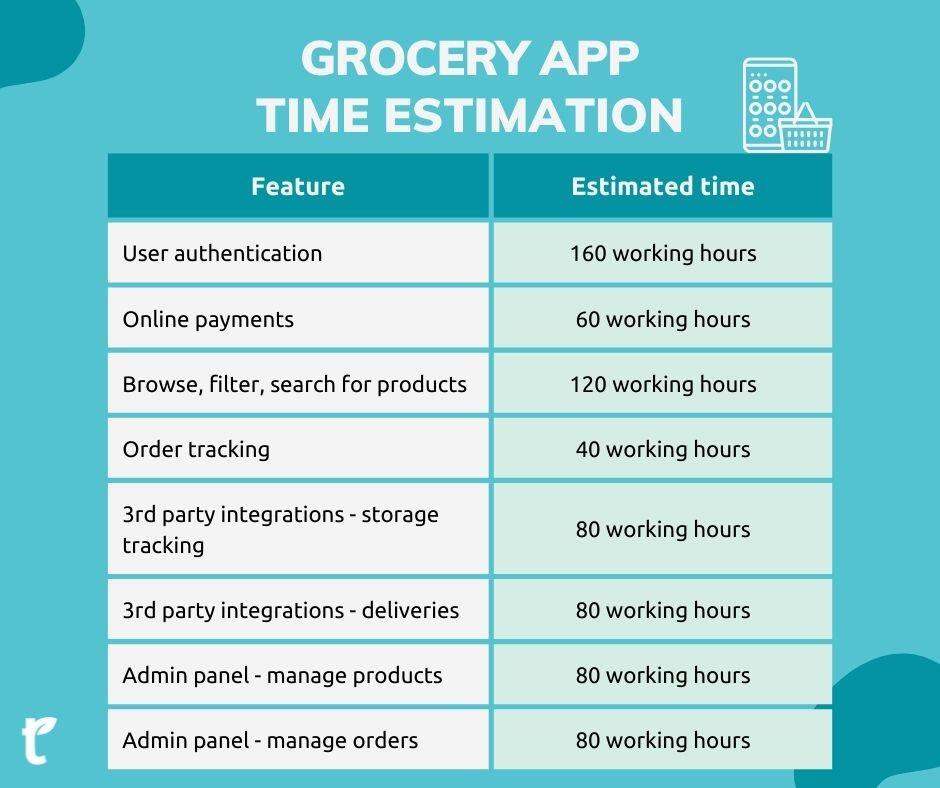
Trip Planning MVP development
To build an MVP for trip planning, we need users to log in, add or choose places, and plan the sightseeing schedule by adding them to a calendar or a map. Users should be able to upload to the app the tickets they buy for the attractions they planned and rate all the places they visited.
The average estimation for trip planning app:
- user authentication (sign-in, signup, recover password): 160 h
- places database: 240 h
- calendar and map planner: 160 h
- rating places: 120 h
- storage for files and links (the tickets storage): 80 h
- admin panel: 160 h
Overall estimation: 920h -> $45k
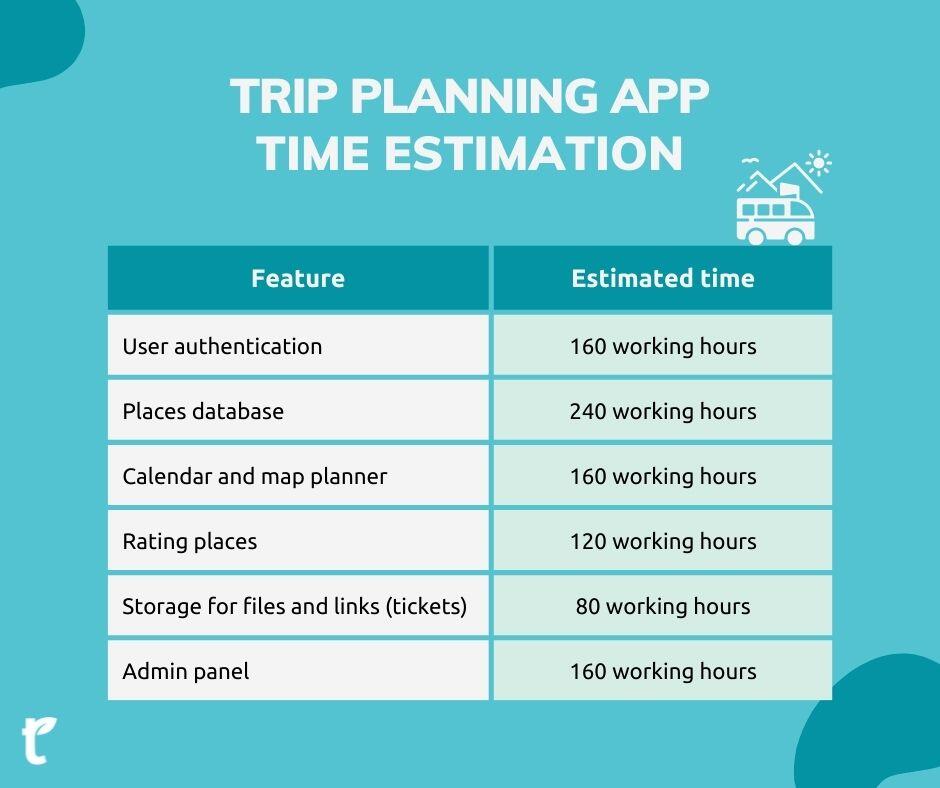
Smart home MVP development
The smart home app is quite straightforward: we need to log in, add people to our home, assign access and permissions to them and connect particular devices.
Keep in mind that every device provider has its own integration rules, so the development costs increase when the database of supported providers grows.
The average cost of MVP development contains:
- user authentication (sign-in, signup, recover password): 160 h
- access and permissions: 120 h
- integrations with 3rd party providers: devices API: 240 – 400 h
Overall estimation: 520-680h -> $25-$35k
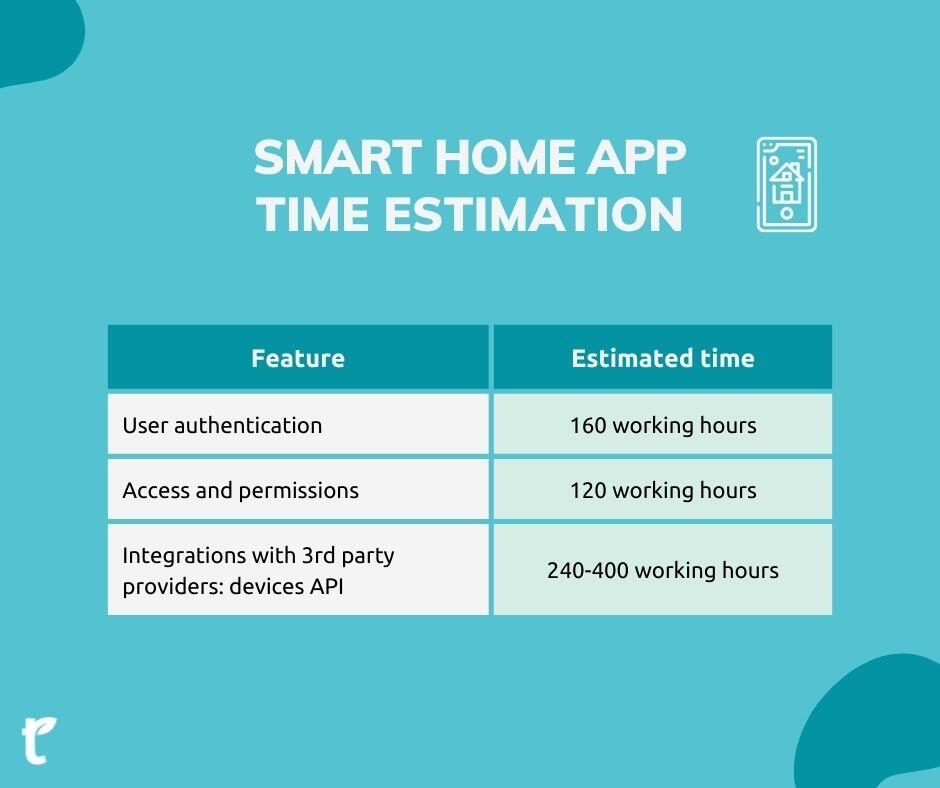
So, how to assess the initial MVP development budget needed?
As you see, there is no universal overall cost range for an MVP development. Development expenses and MVP pricing are defined by the target audience, your MVP concept, the contractor (development company, freelance developers, or in-house team) and its localization, and many other factors.
What I can suggest as a project manager with many years of experience is to put effort into the initial phase of development: business analysis and project discovery stage (including user journey map) to verify the demand on the market and app idea and collect user feedback. You can do this by yourself or entrust that to an experienced development team (like TeaCode).
Such an approach is highly beneficial but omitted by many startups (according to Forbes, it’s one of the main reasons for business failure).
So, the basic question is, how much does it cost? It’s difficult to assess the MVP costs by yourself as you don’t have any experience building such an app. Keep in mind that there are also post-launch costs of maintenance and further development (as it is the first version of the app), adding new features, and so on. You need to be prepared for the marketing cost, too. Those are not included in development estimations, but keep in mind that you should have something to spend to promote your app (you can check our article on app promotion ideas).
Need a hand with estimating your MVP app?
Gabriela is a lead project manager and keeps in mind that the crucial thing in project management is always seeing the business objectives. She takes care of clients' business outcomes, and that's why clients usually give her a lot of independence.
As a web developer, she understands teammates, which is an asset in project management. UX designer background is handy when clients ask her for advice or consult their app ideas. Having this knowledge, she can address their confusedness or curiosity.
Data analysis and research have no secrets from her as she's a physicist. She knows how to discover data patterns and dependencies, which brings additional value to her everyday work.
Social media MVP development
A basic social media app contains profiles that can be searched for, followed or added to the contact list, posts (messages, images, movies, and so on that can be searched, too), comments, and shares. Such an MVP app might also provide basic event functionality.
Additionally, we can add group functionality. The basic time for the development of such a feature varies from 40 to 480 hours, depending on how advanced the solution should be. A basic group with one type of user (an open or closed group with no roles defined) is easy to build, but the development of additional features like different roles and permissions management, surveys, photo album, connected events, group chat and so on is way more time-consuming.
One of the important features of a social media app is notifications. There are many ways in which those can be developed depending on their purpose and behaviour (normal or custom, with activities that can be taken directly from such notifications like writing back or liking).
Another important feature is recommendations. There are two possibilities: developing a simple non-AI/ML solution or using an AI/ML-driven recommendation engine like TeaRex.AI. The second option is way more economical and more effective.
Social media apps are, by default, designed to handle many users and work on a great scale, affecting MVP costs.
The average cost to build a minimum viable product:
Overall estimation: 1180-1740h -> $65-$90k